Stewed Pork Ball in Brown Sauce
Lion head is a traditional dish in the Huaiyang cuisine of Yangzhou, Jiangsu, China. Legend has it that Lion's Head began in the Sui Dynasty, when Emperor Yang of the Sui Dynasty was traveling, the chef made four dishes of squirrel, cinnamon, shrimp cake, Ivory chicken strips and sunflower chopped meat with the theme of Yangzhou Wansongshan, Qianqiandun, Ivory forest and sunflower granite. It is said that the original name was sunflower chopped meat, sunflower meatballs, and Wei Yong's kitchen in the Tang Dynasty. Juyuan made four famous dishes: squirrel and cinnamon fish, shrimp cake with money, Ivory chicken chips and sunflower chopped meat. The guests in the audience were amazed and the sunflower chopped meat was renamed Lion's Head. This dish tastes soft, glutinous and smooth, healthy and nutritious.
Yifeng, Jiangxi Province, also has this dish, popular for more than 100 years, with a white color, fresh and tender meat, fragrant and mellow, all seasons are suitable for characteristics. Anhui Chaohu area every year during the Spring Festival will be colored ball, playing lions, celebrating grain harvest. Local people will then make snacks that resemble lion heads to reward lion dancers. This custom has been popular since ancient times. This snack is very crisp and can be stored for several days without softening due to its slightly higher alkali content than ordinary fermented dough.
Lion's head is made of 60% fat meat and 40% lean meat with onion, ginger, eggs and other ingredients cut into meat paste, made into fist-sized meatballs, can be steamed red-boiled, fat and not greasy. But modern times usually use more lean meat. Xu Ke made a clear account of the barnyard note: "the lion head is named after its shape, and the pork circle is also. The pork is half fat and thin, chopped and chopped. It is made of protein, so that it is easy to solidify, or add shrimps and crab meat. Place one of the yellow sand pots with yellow sprouts or bamboo shoots on the bottom, slightly mixed with water and salt, and make the biggest circle with meat. Place them on top of the pots, cover them with vegetable leaves and cover them with the pot. Put a little salt into the iron pot to prevent the pot from cracking. Then, burn it with fire. When the number of firewood is stopped, it will burn more than five minutes.
The dish has a long history. The Song Dynasty poet said: "but it will match two crabs. There is a Yangzhou crane in the world." To compare eating crab meat to "riding cranes down Yangzhou" happy gods, you can see how delicious crab powder lion head dish. The Qing Dynasty "Tiaoding Ji" in Yangzhou "big meat ball" a dish, the system is as follows: "take ribs, peeled, sliced long strips, coarse, with soybean powder, a small amount of condiments, with the hands loose, can not be rubbed into. Or fried or steamed (with linen green), which is recognized by the society in the Qing Dynasty.
The cooking of the lion's head is very important. Simmer for about forty minutes, so that after making it fat and not greasy, the entrance is changed. Yangzhou Lion Head has three cooking methods: stewing, steaming and braising. As for the variety, there are many kinds, such as stewed crab powder lion Head, clam roasted lion Head and wind chicken roasted lion Head.
The lion's head is a kind of meatball. Iron Lion Head is a dish originated from Cangzhou, Hebei Province, where the God doctor's happy home is located, and the iron lion in Cangzhou is a scene, so it is called the pill iron lion head. The main reason is its large outer Jiao Li Nen. There are also many ways of braised lion heads. And longan lion heads. Steamed lion heads. Some places are called Si Xi balls. The practice is basically the same.
Legend has it that when Suiti visited Qionghua in Yangzhou, he stayed in the south of the Yangtze River, enjoying numerous beautiful scenery. After taking over the four famous landscapes of Wansongshan, Qianqianduan, Ivory Forest and Sunflower Granite in Yangzhou, he admired the landscapes and renamed them Qianjin Mountain, Mao Erdun, Pingshan Hall and Qionghua View. After returning to the palace, he called in the imperial cook and asked them to make four dishes to remember the trip to Yangzhou in the south of the Yangtze River. Wang Chai, the chief cook, worked hard to make four famous dishes. These four dishes are squirrel mandarin fish, money shrimp cake, ivory chicken strips, sunflower chopped meat. Emperor Yang of the Sui Dynasty was very happy after tasting it, so he gave banquets to all his ministers and became a delicacy all over the South of the Yangtze River. Officials and dignitaries entertain guests with pride in these four dishes.
In the Tang Dynasty, it was also the golden dish, jade, and good food. On this day, the public banquet of the State of Pi ordered Wei Juyuan, a famous chef in the mansion, to make four famous dishes: squirrel and cinnamon fish, shrimp cake with money, Ivory chicken sticks, sunflower and chopped meat, accompanied by rare seafood, rare water and land. Guests are breathtaking. When the sunflower chops meat one dish to carry on, sees only uses the huge meatball to make the sunflower heart, magnificent, really looks like the lion's head. In the first half of his life, he lived in the army for nine years, and the guests praised him. The Duke of the State of Pi drank a toast and said, "To commemorate this evening's meeting, sunflower meat might as well be changed to"lion's head." Since then, a famous "lion head" has been added.
In the Qing Dynasty, when the Qianlong came down to the south of the Yangtze River, the dish was brought to Kyoto to make it one of the palace dishes. During the Jiaqing period, Lin Lan of Ganquan also sang Yangzhou's "Sunflower Meatballs" in "Three Songs of the Yongjiang River". Its preface said, "meat is cut into balls with fine cuts, and fried with meat and vegetables into sunflower yellow, common name sunflower meat balls." His poem cloud: "the kitchen Chai has been cut frequently, and this sunflower is letting go. When you are full, you should also think about the sun.
Material Science
150 grams of pork, 10 grams of horseshoe, 10 grams of dried mushrooms, 5 vegetables and a little ginger.
Flavoring
Peanut oil 500 grams (100 grams of fuel consumption), 12 grams of salt, monosodium glutamate 10 grams, 5 grams of sugar, 30 grams of raw meal, chicken soup 150 grams, Laozhao Wang 10 grams, sesame oil 5 grams.
Production process
1. Cut the pork into paste, cut the rice with horseshoe and mushroom, add salt, monosodium glutamate and raw meal until the meat is gummed, and make four big balls. Stir fry the vegetables in the boiling water and stir them into the dish.
2. put the oil in a frying pan, and pour it into a large meatball at a temperature of 130 degrees.
3. Keep oil in the pot, add ginger slices, chicken soup, big meatballs, salt, monosodium glutamate, sugar, old saucer, cook over low heat until the juice is thick, and then use wet raw powder to hook up the sauce into the dish.
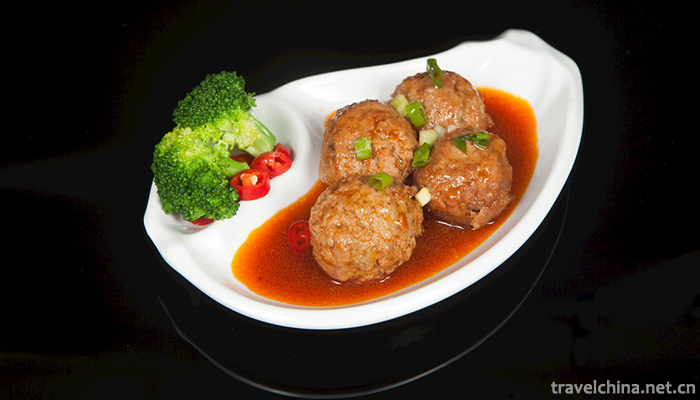
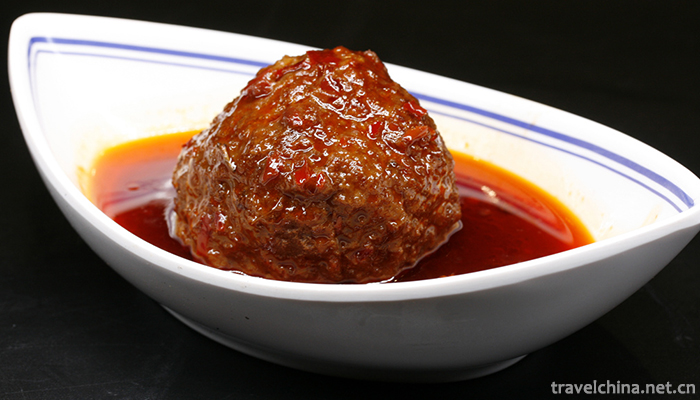
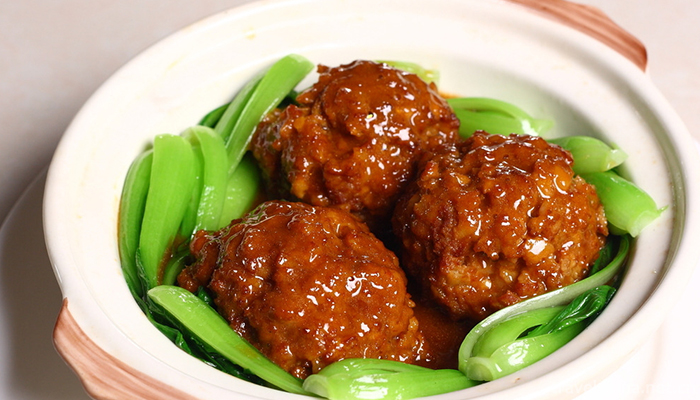
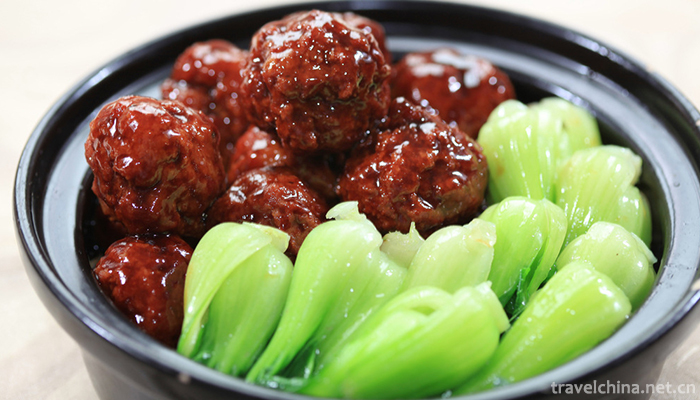
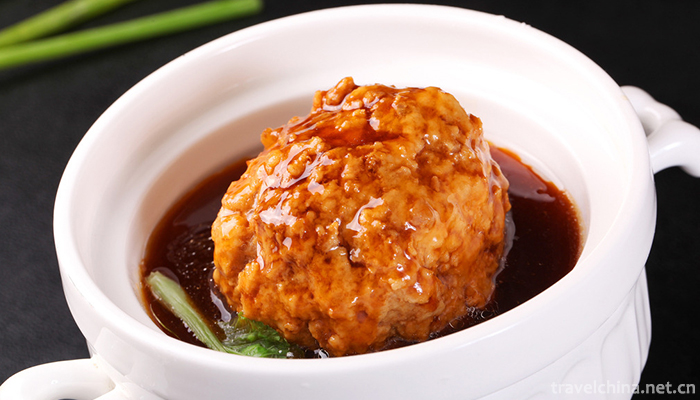
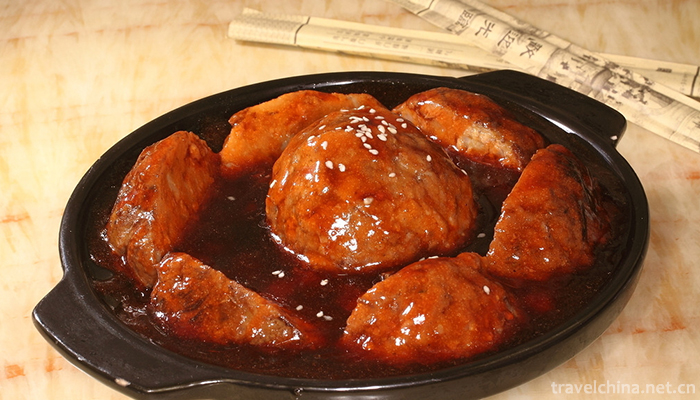
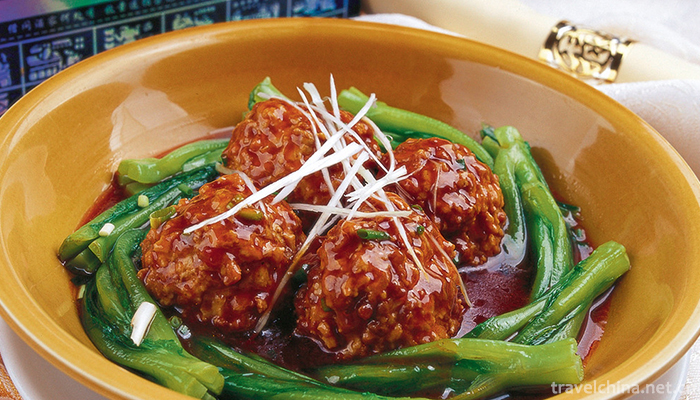
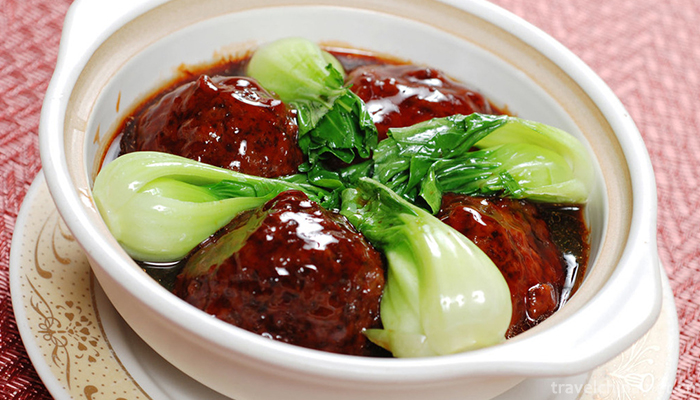
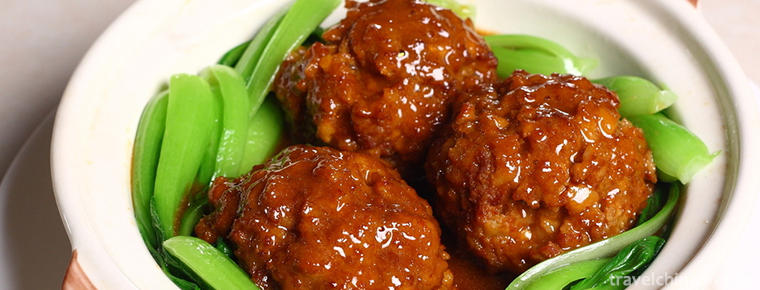
-
1.The Mutianyu Great Wall
The Mutianyu Great Wall in Beijing is located in Huairou District of Beijing, 73 kilometers from the urban area of Beijing. With a long history and splendid culture
Time 2018-11-24 -
2.Huaxia City Tourist Scenic Spot
Weihai Huaxia City Scenic Area belongs to Huaxia Cultural Tourism Group Co., Ltd. It is located in Weihai, a beautiful seaside resort city.
Time 2018-12-08 -
3.Shahu Sand Lake tourist attraction
In 1996, Shahu Lake was listed as one of the 35 trump-card scenic spots in China. In 2000, Shahu Lake was designated as "National Civilized Tourism Scenic Spot" by the Central Office of Spir
Time 2018-12-12 -
4.Five spring mountain
Wuquan Mountain is located at the northern foot of Gaolan Mountain, south of Lanzhou City. It is a famous Longshang resort with a history of more than 2,000 years
Time 2018-12-22 -
5.Sheshan State Forest Park
Shanghai Sheshan National Forest Park was approved by the Ministry of Forestry in June 1993. It is located in Songjiang, an ancient city in the western suburbs of Shanghai. It covers an area of 401 he
Time 2018-12-22 -
6.Liu Sanjie s Grand View Garden
Liu Sanjie Grand View Garden, formerly known as Guilin Liu Sanjie Landscape Garden, is located on the Peach Blossom River in Guilin City, Guangxi Zhuang Autonomous Region. It covers an area of more th
Time 2018-12-26 -
7.Flaming Mountains
Flame Mountain in Xinjiang is the most famous scenic spot in Turpan. Located in the northern margin of Turpan Basin, the northern route of the ancient Silk Road is mainly composed of red sand
Time 2019-01-19 -
8.Qufuming Old Town
Qufuming Old Town: World Cultural Heritage, one of the three holy cities in the world, national AAAAA tourist attractions, National Scenic spots, national key cultural relics protection units, one of
Time 2019-02-07 -
9.Shangdong clapper opera
Shandong Bangzi is a traditional local opera popular in Southwest Shandong and Central Shandong. Also known as "high-profile Bangzi", short for "high-profile" or "high-profile
Time 2019-06-13 -
10.Yangzhou Qingqu
Yangzhou Qingqu, also known as "Guangling Qingqu" and "Weiyang Qingqu", is a form of Musical Singing developed on the basis of popular songs and minors popular in Yangzhou during t
Time 2019-07-10 -
11.Processing Technology of Traditional Chinese Medicine
Processing technology of traditional Chinese medicine, one of the means of preparation or extraction of traditional Chinese medicine, is declared by the Chinese Academy of Traditional Chinese Medicine
Time 2019-08-03 -
12.Bai Juyi
Bai Juyi (772 - to - 6), Le Tian, the number of Xiangshan residence, and Mr. drunken Yin, whose ancestral home is Taiyuan, Shanxi. And moved to his great grandfather. Lower jaw Born in Henan Xinzheng
Time 2019-09-06